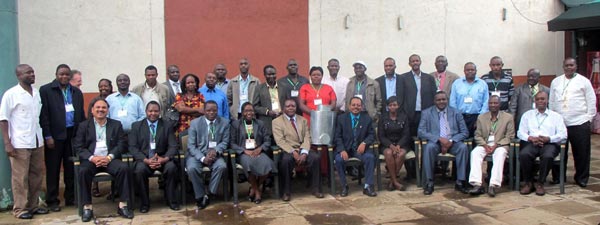“Maize research in the country has contributed to increased productivity by developing high yielding hybrid varieties that give quick returns to the farmers. However, 30% of post-harvest losses incurred during storage due to insect pests such as the larger grain borer and maize weevil; and lack of effective grain storage facilities negates the achievements,” noted Ephraim Mukisira, Kenya Agricultural Research Institute (KARI) director, in a speech read on his behalf by Joseph Ochieng, KARI Food Crops assistant director, during the launch of the second phase of the Effective Grain Storage for Better Livelihoods of African Farmers Project (EGSP-II) in Nairobi, Kenya, on 2 November 2012. “In monetary terms, this loss translates to over 10 billion Kenya shillings (US$ 120 million). Therefore more effort is required in post-harvest management practices and marketing to fulfil millenium development goals and realize Vision 2030 [Kenya’s Blue Print to Industrialization],” added Mukisira.
EGSP-II (2012-2016) builds on the successes of the previous phase (2008-2011) and aims to improve food security and reduce vulnerability of resourcepoor farmers, particularly women farmers, in eastern and southern Africa through the dissemination of effective grain storage technologies. The project is funded by the Swiss Agency for Development and Cooperation (SDC) and will help smallholder farmers in Kenya acquire more than 4,000 metal silos that have proved effective against the larger grain borer and maize weevils – the most destructive storage pests. In addition, smallholder farmers are set to benefit from 24,000 super grain bags.
Mukisira lauded the efforts by national institutions, CIMMYT, and other stakeholders in promoting use of storage technologies, calling for strengthening these efforts even further to achieve economically acceptable post-harvest losses of less than 5%. According to B.M. Prasanna, CIMMYT Global Maize Program director, heavy post-harvest losses prevent Kenya and other countries in the region from achieving food security.
The project’s three components — research, promotion, and policy advocacy for metal silos and super grain bag technologies— are geared towards successful development of a well-functioning and sustainable input chain to provide small-scale maize producers with effective storage technologies, clarified project coordinator Tadele Tefera. EGSP-II will address policy concerns to upscale metal silo technology and test new small-scale technologies based on hermetically sealed bags. Adoption of metal silos is quite expensive for the resourcepoor farmers, and thus has remained low; the new smallscale technology can provide a solution to this problem, as it is a cheap alternative targeting smallholder farmers.
Jones Govereh, CIMMYT policy economist, added: “As a result of lack of adequate awareness and access to appropriate technologies, farmers end up selling their maize soon after harvest, when prices are at their lowest, partly to curb the losses and partly to meet other financial needs. The same farmers are forced to buy the grains back at more than twice the price later in the season to meet their subsistence needs, resulting in a continual poverty trap.” EGSP-II, a major initiative in sub-Saharan Africa, aims to change the situation.

 Capacity development
Capacity development 
